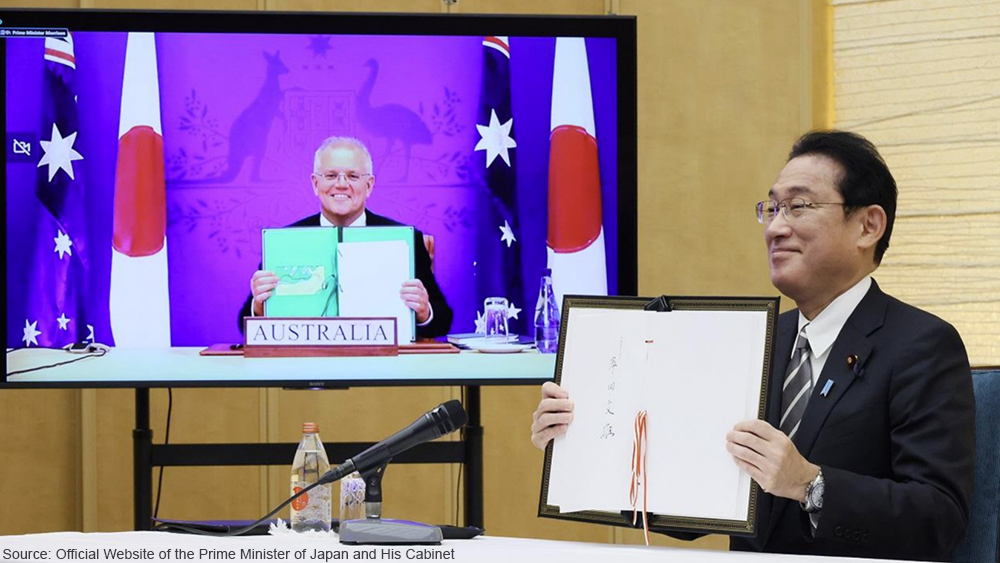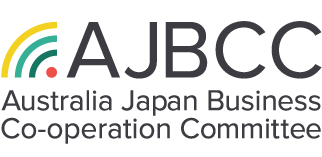18 Jan Prime Ministers get new year off to flying start
Posted at 10:40h
in News

The new year has got off to a flying start for Australia-Japan relations, with the two Prime Ministers, Scott Morrison and Fumio Kishida, meeting virtually on 6 January. While the need for Prime Minister Kishida to deal with the emerging Omicron outbreak in Japan meant he was not able to visit Australia as originally planned, the meeting was of great significance.
Following are our key take-outs:
- The fact the meeting was held at this time is itself an important demonstration of the value both governments place on the relationship. Had Prime Minister Kishida been able to visit in person as originally planned, it would have made Australia his first bilateral overseas destination since taking office – unprecedented for a Japanese PM. For his part, Prime Minister Morrison made time for the meeting while officially on leave, continuing the goodwill created by his own visit to Japan in late 2020, the two PMs’ early contact on Kishida’s appointment, and their in-person discussion in the margins of COP26 in Glasgow. As Japan’s Ambassador Yamagami put it, it seems the two Prime Ministers have already become “mates” – which can only be good for the bilateral relationship.
- The principal outcome of the meeting, the defence-related Reciprocal Access Arrangement, is of very great significance both symbolically and practically. It cements Australia – described in the Japanese media as a “jun doumeikoku”, perhaps best translated as “the next best thing to a formal ally” – as Japan’s second most important security partner after the United States, which is the only other country with which it has a similar agreement. Moreover (while not containing the mutual security assurances that would characterise a formal alliance) it is the first such agreement Japan has that is truly reciprocal, allowing both parties similar access to each other’s territory and defence facilities. And in practical terms it will greatly simplify the legalities around joint activities, including training exercises and disaster relief, enabling the Australian and Japanese defence forces to work far more closely together whatever the challenges they are confronting. As Prime Minister Morrison noted, it is a vital step towards making Australian and Japanese forces truly interoperable.
- While many commentators focused on the Agreement in the context of both countries relations with China, in reality it is the product of a much broader evolution in Australia-Japan defence relations – starting from the Joint Declaration on Security Cooperation in 2007; defence cooperation on relief in the aftermath of the Tohoku Earthquake, Tsunami and Nuclear disasters in 2011; through the entry into force of an Information Sharing Agreement and an Acquisition and Cross Servicing Agreement in 2013; and the elevation of the relationship to a Special Strategic Partnership in 2014. The first public reference by an Australian official to the need for such an agreement was by then Ambassador Bruce Miller at the National Press Club in Tokyo in October 2011. The Agreement really signifies the maturing of the Defence relationship into one that has real, practical and mutually beneficial activity at its core. From a business perspective, this also helps reinforce the potential for further collaboration on defence and related industry possibilities.
- The Joint Statement issued by the two leaders is remarkable for its detail and for the extent of activity it reveals. Traditionally, Australia-Japan official statements were heavily focused on the economic relationship, and political references tended to be bland and general. In this case, strategic partnership has taken centre stage, including some relatively forthright statements on a wide range of regional issues. But the statement also contained important elements for the commercial relationship: notably welcome confirmation that Australia would participate in the Osaka Expo in 2025, providing valuable lead-time for preparation of an exhibit that can showcase bilateral collaboration; and an announcement by Australia that Japan will be the principal initial focus of its $150 million Australian Clean Hydrogen Trade Program, as well as collaborative efforts to promote energy transition in the Indo-Pacific.
- Overall, the meeting provides a highly favourable backdrop from Government on both sides of the relationship for the pursuit of Australia-Japan business opportunities in the coming year. And while it is regrettable – if understandable – that a visit to Australia by Prime Minister Kishida ultimately could not be realised, that cloud potentially has a silver lining: Ambassador Yamagami has emphasised he remains committed to ensuring the Prime Minister of Japan visits Australia at an early opportunity. Hopefully this very welcome intention can be realised at a time that will also permit activities beyond government-to-government discussions, and full involvement by the business community, in recognition of the firm commercial base on which our mutual trust has been built.
Further reading
- Deeper ties with Japan send strong message to China | Australian Strategic Policy Institute | ASPI
- Japan defence deal unsettling to China, says expert | theaustralian.com.au
- Security relationship with Japan is only the beginning for Australia | East Asia Forum
- Australia can learn from Tokyo’s smarter approach to China | Nikkei Asia
- Japan–Australia defence deal opens up opportunities for closer cooperation | The Strategist (aspistrategist.org.au)
- Australia-Japan treaty: China’s fury over joint statement | news.com.au



